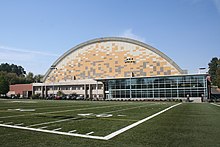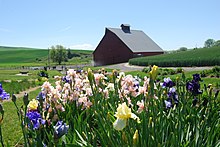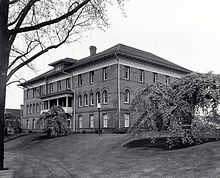University of Idaho
Stevenson for his actions in styming the nearly successful effort to detach the north Idaho Panhandle and join the state of Washington.
"[19] According to the U of I Facts Books, the Moscow campus, abutting the Washington state line, is 1,585 acres (2.5 sq mi; 6.4 km2), including 253 buildings with a replacement value of $812 million.
The Administration Building, with its eighty-foot (24 m) clock tower and Collegiate Gothic-style structure, was built from 1907 to 1909 and has become an icon of the university.
[23] The original Administration building, with a single tall spire reaching to 163 feet (50 m), was constructed through the decade of the 1890s and ultimately finished in 1899.
The new Administration building was designed by John E. Tourtellotte, who modeled the new structure after Hampton Court Palace in England.
[26] Two years out of office, former U.S. president Theodore Roosevelt spoke outside the main east entrance of the new building on April 9, 1911, on a platform built of Palouse wheat.
It includes monuments such as Presidential Grove, where historical figures, such as Teddy Roosevelt, planted trees; the Spanish–American War memorial statue who had his hands cut off but was reconstructed by the handless sculptor Bud Washburn;[27] and Administration Lawn that was designed by the Olmsted Brothers.
For students, the Pitman Center also features meeting rooms, a computer lab, wireless access, borrowable laptops and a movie theater.
The VandalStore, built in 1989 on a former parking lot, is located directly across the street to the east; it was previously adjacent to the south.
[33] UI's multi-purpose "Kibbie Dome" is the primary home to Vandal athletics; it is the venue for football, soccer, tennis, and indoor track & field.
Tartan Turf, similar to AstroTurf, was installed in 1972 with the roll-up mechanism; the arched roof and vertical end walls were completed in time for the 1975 home opener on September 27, enclosing the stadium to become the Kibbie Dome.
The university had attempted to build a new arena to replace Memorial Gym for over 50 years,[35] but nothing came of the plans until 2018, when a $10 million naming gift from Idaho Central Credit Union encouraged the administration to go forward with construction.
[37] The 4,200-seat facility, costing about $51 million, is primarily made from engineered wood, with the superstructure consisting mainly of over 850 Douglas fir beams prepared from trees logged at the university's experimental forest.
Due to its demanding rolling terrain and southwesterly summer winds, the par-72 course's moderate length of 6,637 yards (6,069 m) from the back tees yields a challenging slope of 135 with a scratch rating of 72.4.
His efforts gradually turned a treeless slope southwest of the Administration Building into a dense forest grove.
The newer portion of the arboretum complex is south of the Shattuck area, in the valley below the president's residence (1967), along the eastern edge of the University of Idaho Golf Course.
The Library also has materials by many famous Idahoans, including Ezra Pound, Vardis Fisher, Frank Bruce Robinson, and Carol Ryrie Brink of Moscow.
[45] Directly north of the Memorial Gymnasium and built on the former site of tennis courts, the library opened in 1957,[46] relocating from the south wing of the Administration Building.
[47] The Tudor Gothic-style Memorial Gymnasium is another U of I icon, known for its whimsical athletic gargoyles perched along the brick building's ledges.
[48][49] Memorial Gym was the primary venue for men's basketball until January 1976,[50][51][52] following the enclosure of the Kibbie Dome the previous fall.
The women's team hosted its home games in the gym until 2001, when the Cowan Spectrum (inside the Kibbie Dome) was completed.
The gym is still in active use today as the home court for the women's volleyball team, and was also used for early-season basketball games before the opening of ICCU Arena.
[53] The MacLean baseball field was located directly south of the Memorial Gym, until its infield was displaced by the construction of the College of Education building in 1967.
The catcher and batter faced southwest (towards the pitcher's mound); the right field line was just south of the gym, running east–west.
The batter and catcher now faced southeast, toward campus, an unorthodox configuration resulting in a difficult sun field for the left side of the defense (the recommended alignment is east-northeast).
This was the fifth consecutive year Idaho has earned this highest federal recognition for its commitment to service-learning and civic engagement.
Yellow gold and black were the colors used by most of the varsity teams from 1978 to 1996, initiated by first-year head football coach Jerry Davitch's new uniforms for 1978.
The Kibbie Dome is the home of the Idaho Vandals for four sports (football, tennis, indoor track and field, soccer).
Basketball was played in the venue until the autumn 2021 opening of the adjacent Idaho Central Credit Union Arena.










